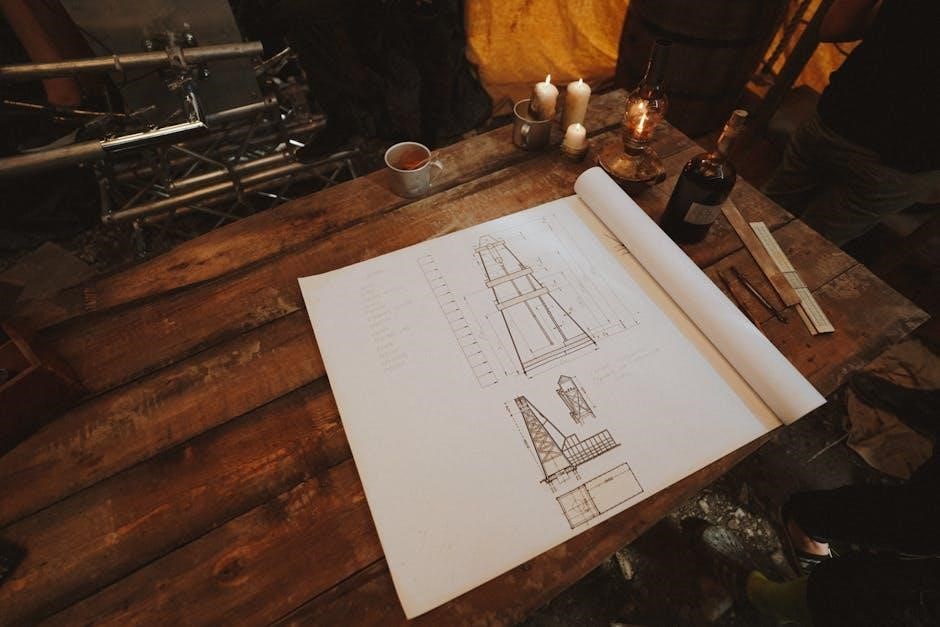Importance of Construction Documents in Project Management
Construction documents serve as the blueprint for projects‚ ensuring clarity‚ compliance‚ and collaboration. They minimize risks‚ prevent disputes‚ and guarantee adherence to legal and safety standards‚ fostering successful project outcomes.
1.1. Role in Ensuring Project Clarity
Construction documents provide a clear‚ detailed visual representation of the project‚ ensuring all stakeholders understand the scope‚ design‚ and execution. They prevent confusion by aligning expectations‚ outlining timelines‚ and specifying deliverables‚ fostering a shared understanding among architects‚ contractors‚ and clients from the outset.
1.2. Legal and Compliance Requirements
Construction documents ensure legal compliance by adhering to building codes‚ permits‚ and zoning laws. They guarantee projects meet safety and regulatory standards‚ protecting stakeholders from legal repercussions. Compliance with these requirements is essential for avoiding fines and ensuring the project’s legitimacy and safety.
1.3. Minimizing Risks and Disputes
Complete construction documents reduce risks by providing clear‚ unambiguous plans and specifications. They outline roles‚ responsibilities‚ and timelines‚ minimizing misunderstandings. Proper documentation ensures all stakeholders are aligned‚ reducing disputes and potential legal issues. It also serves as a reference for resolving conflicts and ensuring accountability throughout the project lifecycle.

Types of Construction Documents
Construction documents include architectural plans‚ structural drawings‚ MEP designs‚ and landscape plans. These documents guide project execution‚ ensuring accuracy and compliance with design and safety standards.
2.1. Architectural Plans
Architectural plans outline the building’s layout‚ including floor plans‚ elevations‚ and sections. They detail spaces‚ doors‚ windows‚ and materials‚ ensuring the design aligns with client vision‚ safety codes‚ and structural integrity‚ while guiding contractors during construction.
2.2. Structural Engineering Drawings
Structural engineering drawings detail the building’s framework‚ including beams‚ columns‚ and foundations. They ensure stability and safety by specifying materials‚ loads‚ and connections‚ adhering to engineering principles and regulations to prevent failures and ensure the structure can withstand various stress conditions effectively.
2.3. Mechanical‚ Electrical‚ and Plumbing (MEP) Designs
MEP designs outline the systems for heating‚ cooling‚ ventilation‚ electrical power‚ and water distribution. These detailed plans ensure efficient system installation‚ compliance with safety codes‚ and proper functionality‚ integrating seamlessly with architectural and structural elements to meet building performance and occupant comfort requirements effectively.
2.4. Landscape and Civil Engineering Plans
Landscape and civil engineering plans detail site grading‚ drainage‚ roads‚ and green spaces. They ensure proper land utilization‚ environmental compliance‚ and infrastructure integration‚ enhancing functionality and aesthetics while addressing soil stability and water management to create sustainable and visually appealing outdoor environments for buildings and communities effectively.

Key Components of a Full Set of Construction Documents
A full set of construction documents includes floor plans‚ elevations‚ cross-sections‚ schedules‚ and site plans‚ ensuring comprehensive project details for accurate execution and compliance with design specifications.
3.1. Floor Plans and Elevations
Floor plans detail each level’s layout‚ including rooms‚ dimensions‚ doors‚ and windows. Elevations provide front‚ side‚ and rear views‚ showcasing the building’s exterior. Together‚ they guide contractors‚ ensuring accurate project execution and compliance with design specifications‚ while also aiding in understanding the spatial and aesthetic aspects of the structure.
3.2. Cross-Sections and Details
Cross-sections reveal internal structures‚ such as walls‚ floors‚ and roofs‚ providing depth and clarity. Details highlight specific elements like joints‚ beams‚ and materials. These visuals ensure precise construction‚ reduce ambiguity‚ and aid in understanding complex components‚ crucial for maintaining quality and structural integrity throughout the project.
3.3. Schedules and Specifications
Schedules outline project timelines‚ materials‚ and resources‚ ensuring organization. Specifications detail requirements for materials‚ equipment‚ and construction methods. Together‚ they provide clear guidelines‚ reduce errors‚ and ensure compliance with standards‚ aiding in smooth project execution and meeting stakeholder expectations effectively.
3.4. Site Plans and Survey Reports
Site plans illustrate the project’s layout‚ including buildings‚ roads‚ and utilities. Survey reports provide topographical data‚ boundaries‚ and existing conditions. These documents ensure proper land use‚ compliance with regulations‚ and inform stakeholders of potential site challenges‚ aiding in accurate project planning and execution.

Industry Standards for Construction Documentation
Industry standards like ISO and ASTM ensure consistency and quality in construction documents‚ guiding technical drawings‚ specifications‚ and compliance with local regulations for safe and efficient project execution.
4.1. ISO Standards for Technical Drawings
ISO standards for technical drawings ensure consistency‚ clarity‚ and precision in construction documentation. They provide a universal framework for creating and interpreting drawings‚ fostering collaboration and compliance with international best practices‚ thereby enhancing the quality and reliability of construction projects globally.
4.2. ASTM Standards for Construction Specifications
ASTM standards provide detailed specifications for materials‚ testing methods‚ and construction practices. These standards ensure quality‚ safety‚ and reliability in building projects‚ guiding contractors and manufacturers to meet industry benchmarks while adhering to precise technical requirements for optimal project execution and compliance with regulatory demands.
4.3. Local Building Codes and Regulations
Local building codes and regulations dictate specific requirements for safety‚ accessibility‚ and environmental compliance. These rules vary by jurisdiction and must be meticulously followed to avoid legal issues and ensure public safety‚ making them a critical component of any construction project’s documentation and planning process.
The Role of Stakeholders in Document Preparation
Stakeholders‚ including architects‚ contractors‚ and clients‚ collaborate to ensure construction documents meet project goals. Their input guarantees accuracy‚ feasibility‚ and alignment with expectations‚ fostering successful project execution and satisfaction for all parties involved.
5.1. Responsibilities of Architects and Designers
Architects and designers are responsible for creating detailed and accurate construction documents‚ ensuring design intent is clear. They oversee the development of plans‚ elevations‚ and sections‚ collaborating with engineers to integrate structural and MEP elements‚ and ensuring compliance with building codes and client requirements‚ forming the foundation for successful project execution and stakeholder satisfaction.
5.2. Input from Contractors and Subcontractors
Contractors and subcontractors provide critical feedback on constructability‚ identifying potential issues in the construction documents. They review plans for feasibility‚ offer insights on material availability‚ and ensure compliance with safety standards‚ contributing to cost-effective solutions and project efficiency while maintaining adherence to the overall design and client expectations.
5.3. Client Expectations and Requirements
Clients provide specific expectations and requirements that shape the construction documents. Their input ensures the project aligns with their vision‚ budget‚ and timeline. Effective communication helps incorporate their preferences‚ leading to a finalized set of documents that meet their needs‚ ensuring satisfaction and successful project delivery from start to completion.

Best Practices for Preparing Construction Documents
Clarity‚ precision‚ and consistency are key. Use standardized templates‚ ensure accuracy in specifications‚ and maintain version control. Regular reviews and stakeholder collaboration guarantee high-quality‚ error-free documents for successful project execution.
6.1. Clarity and Precision in Drawings
Clarity and precision in construction drawings are essential for accurate interpretation. Use consistent scales‚ clear labels‚ and avoid ambiguities. Detailed annotations and standardized symbols ensure all stakeholders understand the design intent‚ reducing errors and miscommunication during construction. Regular reviews and updates maintain accuracy throughout the project lifecycle.
6.2. Accuracy in Specifications and Schedules
Ensuring accuracy in specifications and schedules is critical for project success. Detailed material lists‚ precise quantities‚ and compliance with standards must be verified. Regular updates and cross-referencing with drawings prevent discrepancies‚ ensuring that all elements align and meet the project requirements effectively.
6.3. Version Control and Document Management
Effective version control ensures all stakeholders access the latest documents‚ preventing errors from outdated information. Centralized management systems track changes‚ maintain consistency‚ and enhance collaboration‚ while automated alerts notify teams of updates‚ ensuring everyone works with current and accurate construction documentation throughout the project lifecycle.

The Shift to Digital Construction Documents
Digital construction documents enhance efficiency‚ accessibility‚ and collaboration. They enable real-time updates‚ reduce errors‚ and streamline communication‚ making projects more manageable and sustainable in the modern era.
7.1. Benefits of PDF Formats
PDF formats offer universal compatibility‚ ensuring documents are viewed consistently across devices. They provide security through encryption‚ preserve layout integrity‚ and allow easy annotations‚ making them ideal for sharing and archiving construction plans and specifications efficiently. This ensures clarity and professionalism in project documentation and communication.
7.2. Tools for Creating and Editing PDF Documents
Tools like Adobe Acrobat‚ Bluebeam Revu‚ and Foxit PhantomPDF enable creation and editing of PDFs‚ offering features like markups‚ annotations‚ and version control. These tools enhance collaboration‚ ensuring accurate and efficient document management in construction projects‚ while maintaining the integrity and security of sensitive information.
7.3. Collaboration and Sharing in Digital Platforms
Digital platforms like Relativity‚ Procore‚ and Autodesk enable real-time collaboration‚ secure sharing‚ and version control of construction documents. These tools facilitate teamwork‚ ensure document consistency‚ and provide controlled access‚ enhancing efficiency and reducing errors in project management workflows.

Review and Approval Process
The review and approval process ensures construction documents meet quality‚ safety‚ and compliance standards. It involves structured steps‚ stakeholder feedback‚ and final sign-offs to proceed with project execution confidently.
8.1. Steps Involved in Document Review
The document review process starts with initial checks for completeness and accuracy‚ followed by detailed stakeholder evaluations‚ feedback incorporation‚ and final approvals. Each step ensures clarity‚ compliance‚ and alignment with project goals‚ minimizing errors and delays.
8.2. Tools and Software for Collaborative Review
Tools like Bluebeam‚ Autodesk‚ and Adobe Acrobat enable real-time collaboration‚ allowing stakeholders to annotate‚ track changes‚ and manage versions efficiently. These platforms enhance communication and streamline the review process‚ ensuring all feedback is captured and addressed promptly.
8.3. Ensuring Compliance During Approval
Compliance during approval involves verifying that documents meet legal‚ safety‚ and regulatory standards. By integrating checks against ISO‚ ASTM‚ and local building codes‚ stakeholders ensure adherence to requirements‚ reducing legal risks and project delays.

Common Mistakes to Avoid
Common errors include incomplete data‚ ambiguous specifications‚ and non-compliance with standards. These oversights can lead to project delays‚ legal issues‚ and increased costs‚ undermining overall success.
9.1. Incomplete or Ambiguous Information
Incomplete or ambiguous details in construction documents can lead to project delays‚ misinterpretations‚ and costly rework. Missing data or unclear specifications confuse contractors‚ causing errors and requiring revisions. Ensuring thorough and precise documentation is crucial to avoid misunderstandings and ensure smooth project execution.
9.2. Non-Compliance with Standards
Non-compliance with industry standards in construction documents can result in legal penalties‚ project failures‚ and safety hazards. It is critical to adhere to regulations and codes to avoid rework‚ delays‚ and potential legal disputes‚ ensuring the project meets required quality and safety benchmarks.
9.3. Poor Communication Between Stakeholders
Poor communication among stakeholders can lead to misunderstandings‚ delays‚ and project failures. Ensuring clear‚ timely‚ and transparent exchanges of information is vital to avoid conflicts and ensure all parties are aligned with project goals and requirements‚ fostering collaboration and successful outcomes.

Case Studies and Examples
Case studies highlight the impact of comprehensive construction documents‚ showcasing successful project outcomes and lessons learned from real-world examples‚ demonstrating effective document management and collaboration.
10.1. Successful Projects with Comprehensive Documentation
Projects with thorough construction documents‚ like the Sydney Opera House‚ showcase how detailed plans and clear communication ensure timely delivery. Comprehensive documentation aligns stakeholders‚ reduces errors‚ and enhances overall project success‚ serving as a blueprint for future endeavors and setting industry benchmarks.
10.2. Lessons Learned from Document-Related Issues
Projects often fail due to incomplete or ambiguous documentation‚ leading to delays and disputes. Ensuring clarity‚ accuracy‚ and compliance is crucial. Proper version control and stakeholder communication can mitigate risks‚ highlighting the importance of meticulous document management in construction projects to avoid costly errors and ensure smooth execution.

Future Trends in Construction Documentation
Future trends include integrating BIM and CAD for enhanced precision‚ AI-driven document automation‚ and adopting sustainable practices. Digital platforms will streamline collaboration‚ ensuring efficient‚ accurate‚ and eco-friendly project documentation.
11.1. Integration of BIM and CAD Technologies
The integration of BIM and CAD technologies enhances collaboration by providing a unified platform for detailed design and project modeling. This streamlines workflows‚ reduces errors‚ and supports real-time updates‚ fostering sustainable and efficient project execution and improving overall outcomes.
11.2. Use of AI for Automated Document Generation
AI streamlines construction documentation by automating the creation and management of project files. It enhances efficiency through intelligent formatting‚ reduces manual errors‚ and ensures consistency across documents‚ enabling faster approvals and minimizing delays in project execution.
11.3. Sustainability and Green Building Documentation
Sustainability-focused construction documents integrate green building standards‚ energy-efficient designs‚ and eco-friendly materials. They ensure compliance with LEED and BREEAM certifications‚ promote environmental responsibility‚ and support long-term cost savings through optimized resource management and reduced carbon footprints in building projects.
Construction documents are vital for project success‚ ensuring clarity‚ compliance‚ and efficiency. Their evolution‚ from traditional to digital‚ underscores their enduring importance in modern construction practices and management.
12.1. Recap of Key Points
Construction documents are essential for modern projects‚ ensuring clarity‚ compliance‚ and risk reduction. They provide a comprehensive guide from planning to execution‚ minimizing disputes and ensuring safety. The shift from traditional to digital formats‚ such as PDFs‚ enhances accessibility and collaboration. Best practices‚ including accuracy and version control‚ are crucial for successful project management.
12.2. The Evolution of Construction Documentation
Construction documentation has evolved from manual drafting to digital formats like PDFs‚ enhancing accuracy and accessibility. The integration of CAD‚ BIM‚ and digital tools has streamlined processes‚ improved collaboration‚ and supported sustainability. This transformation ensures documents are more precise‚ shareable‚ and aligned with modern project demands‚ fostering efficiency across the industry.
12.3. Final Thoughts on Best Practices
Adopting best practices in construction documentation ensures project success; Embrace digital tools for clarity‚ precision‚ and collaboration. Regular updates‚ version control‚ and stakeholder communication are crucial. By integrating modern techniques and avoiding common pitfalls‚ teams can deliver accurate‚ compliant‚ and sustainable projects‚ setting new standards for the evolving construction industry.
